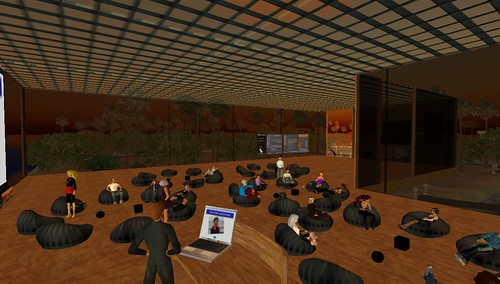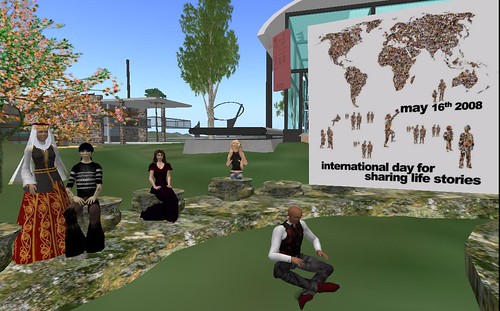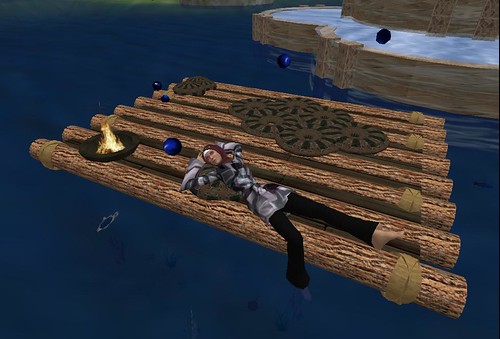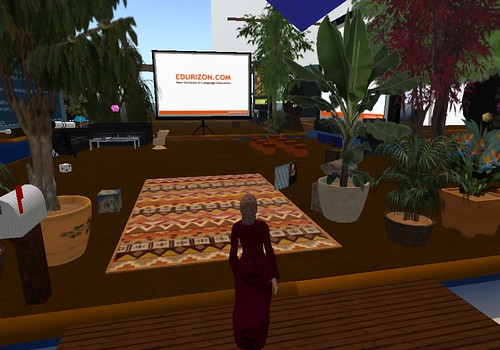My avatar
I remember that I was horrified at what I looked like when I came into being in Second Life. At that time, Linden Lab(s) didn’t have such a choice of avatars right from the beginning. However, I was still very happy that I was at least wearing clothes. A significant number of avatars seemed to be “born” naked into SL. My clothes, consisted of an ugly pair of jeans and a block-striped red-and-white sweater — the only choice if I didn’t want to look half-naked. Obviously, the first thing I did was to try and change my appearance. With no money at all, and no idea at that time that there were freebie stores, my choices were limited to the “Appearance” menu. But whatever I tried, I remained ugly . Consequently, no pictures of me from that time exist 🙂
My identity
Interesting for me is, how I identified with my avatar from the start and wanted it to represent me and had chosen a name related to my real life name. That was why I was really unhappy about what “I” looked like. I am also a very visual person and learner and trained and worked as a photographer so visuals are important to me.
Orientation Island
I like to figure out things on my own and had been using all kinds computer software and the Internet for quite some time plus I found the Orientation Island and the people I met there boring. I was also extremely curious about the places in SL. So, I ventured into my new Second Life skipping most of the tutorials. Only later did I realise that this had not been a good idea. There was just too much to learn and the trial and error approach was taking too long.
The next paragraph is a quote from my other blog of June 20, 2008
I have to say, I was rather disappointed because of the poor graphics, the empty places and the steep learning curve. I had also no idea how to find those educational places. Most places I managed to find were deserted. The first conversations I had with “residents” were also not very promising.
It took a couple of months for me to give it another try. I learned how to move around watching some Second Life tutorials. And after attending a live guided demonstration during a six-week EVO BAW08 course, I finally started to understand its significance for education. I was intrigued by the possibilities it offered for distance and language learning.
I started to collect teaching tools and to learn more basic SL skills. An online teacher friend from Mexico, Maru suggested to meet once a week to learn and share our experiences. This was a great motivator for me. Shortly afterwards, we were joined by Alicia, a teacher friend from Uruguay.
Motivating: Learning with a group
As I mentioned in my blog post above, having a group to learn together with was extremely motivating for me. Now, I was eager to learn more in order to have something to share with the others. I attended many events, conferences, talks and workshops, met many interesting people and had a growing list of friends that I could ask for help or simply socialise with.
Jeremy Harmer’s first presentation in Second Life
Virtual Morocco – a University project
Daffodil contemplating her findings.
Second Life Friends and a my first “home”
By now, I had also met some generous people who had given me some decent clothes and even a small place of my own where I could set my “home” button to. I was looking more acceptable now (at least to myself) and I wasn’t bumping into walls that much any longer 🙂
My first “home” base.
SL beginners need guidance
Thinking back to my experience, the frustration and loneliness I felt and the hours spent on searching places of interest, I always accompany my friends that I introduce to Second Life right from the signing-up process to the first hour in SL. I help them through Orientation Island, show them other OI they can go to when they want to learn a news skill and we go shopping for the first freebies. Of course, they add me as a friend, and I explain how they can contact me in-world to ask for help.
Important step forward: specialised Orientation
I think one important step forward are specialised sign-up pages and Orientation stations for specific groups like ISTE for teachers, preferably staffed with life tutors or guides. When I recommend SL to educators or business people, I do not give them the general secondlife.com link but the one for educators and business people where there are more appropriate pictures and descriptions of SL..
A side note: While doing this MUVEnation task, I learned how to send snapshots from SL directly to flickr .




